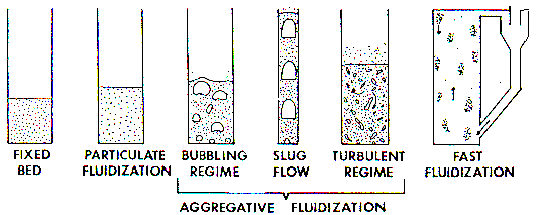-
What is fluidisation?
Date posted:
-
-
Post Author
dev@edge.studio
1. Principles of Fluidisation
[GLOSS]Fluidisation[/GLOSS] is a process in which a bed of particles is converted to a fluid state by means of an upward flow of gas (or liquid). When a fixed bed of particles is exposed to an upward flow of gas the individual particles gradually tend to move apart and an expansion of the bed becomes noticeable (expanded bed). The pressure drop increases with a rising gas flow. At high airflow rates, a point is reached at which the pressure drop becomes equal to the weight of the bed, which enters into a state of [GLOSS]incipient fluidisation[/GLOSS].
Any additional airflow tends to move through the bed under an inherently unstable form of rising bubbles (bubbling bed). The rising bubbles push aside the particles and aspire them in their wake. The particles move around erratically, which leads to a fast transport of heat in the bed despite the low thermal conductivity of both the gas and the particles. The same phenomena determine the mass exchange between the gas (combustion air) and fuel particles suspended in the bed material.
A bubbling bed resembles a boiling liquid, with regard to:
- the horizontal boundary between the fluidised bed and the gas phase above it
- the fluid-like characteristics of the bed, which flows out of a hole, pierced in the side-wall, or over a weir, installed in the bed
- the principle of communicating fluidised vessels (of equal or different apparent density)
- the facility of light materials to float and dense materials to sink in the bed to achieve separation
- the hydrostatic pressure, which rises with the depth in the bed
- the steady but erratic movement of individual particles
The bubbles emerging at the surface splash bed material around and finer particles are entrained and may remain gas-borne. The bubbles originate at the distributor (a device which generally supports the bed), detach from it, rise and inflate, merge or split, and eventually reach the surface of the bed. The vertical movement of these clusters of bubbles brings about a steady circulation of the bed material, which is pushed upward by the bubbles or aspired in their wake. This results in a thorough and steady mixing of bed materials. At sufficiently high bubbling rates floating light or settling dense material are spread homogeneously throughout the bed. A high rate of heat transfer from the bed to the wall and bed internals is also achieved. The bed temperature tends to be strictly homogeneous, even when strongly exothermic or endothermic processes take place in it. In addition, solids are steadily exposed to the gas phase, present in between the circulating particles and, to a minor extent, to the gas in bubbles. The latter also have a lower residence time in the bed, so that gas short-circuiting of the bed occurs to a certain extent.
For practical purposes a fluidised bed is operated using a gas velocity well above that required for incipient fluidisation. In the fluidised state the pressure drop no longer increases significantly with rising gas flow. When the gas flow rate further increases slugging may occur. Slugging is a situation, occurring frequently in narrow slender beds, in which the bubbles grow in size and coalesce so that they cover essentially the entire bed cross section. The slugs push the bed material upwards until it rains through them, temporarily breaking up the slug. A slugging regime is undesirable because it is accompanied by erratic pressure shocks and a rather poor gas/particle contact.
When the gas flow rises even further the bed is termed turbulent, fast in a riser regime. A circulating fluid bed operates at velocities, which correspond to a regime of [GLOSS]pneumatic transportation[/GLOSS].

Figure 1: Different stages of fluidisation.
2. Classification of Particles
Very small particles (below 20 microns) are almost impossible to fluidise: the gas tends to circulate through discrete canals (channelling). A bubbling behaviour is possible in a range between 0.1 and 1mm. Larger particles may be fluidised in a bed of finer particles, but when the difference in density or size is too high and the gas flow rate too small, segregation (i.e. settling of dense or floating of light material) will occur. Geldart’s classification of powders subdivides these into:
- homogeneously fluidisable powders
- powders fluidisable with a bubbling regime; e.g. sand
- cohesive powders, difficult to fluidise, e.g. cement and fly-ash
- pellets, fluids
- others able with a bubbling regime, e.g. plastic pellets, corn.
Keywords:
Fluidisation, expanded bed, bubbling bed, fast fluidisation, particle classification, incipient fluidisation
Source:
[1] Basu P. editor (1984): Fluidised Bed Boilers: design and application. Pergamon Press.
[2] Technical Brief from Residua & Warmer Bulletin: Fluidised bed combustion. http://www.residua.com/wrftbfbc.html
